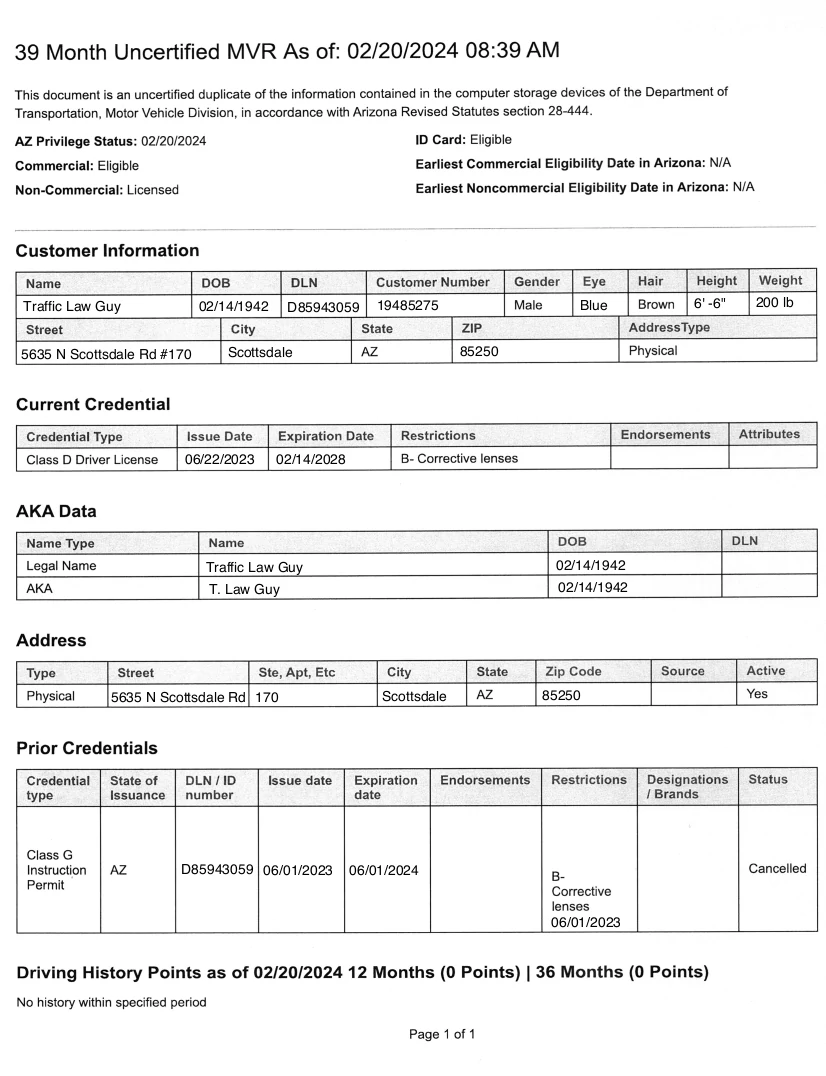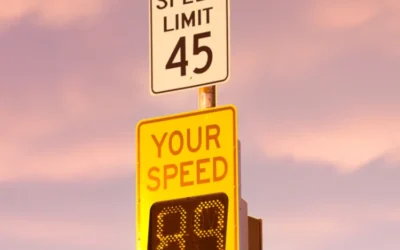MVD Points System in Arizona
How do you get them, and what happens if you get too many.
Some Definitions
ADOT
is the Arizona Department of Transportation.
MVD
is the Motor Vehicle Division of the Arizona Department of Transportation. To get a driver license, you might go to the MVD office, which is operated by ADOT. ADOT and MVD can often be used interchangeably.
Corrective Action
is what ADOT calls the things they do to drivers, like license suspensions or a traffic survival school assignment.
Corrective Action Notice
is the letter that ADOT sends to drivers stating what corrective action is being taken and when.
Points
Drivers are always worried about points, but points are only relevant to one thing – Is the MVD going to do something to the driver? Points are a weighting scheme that ADOT uses to weight the severity of violations and determine if action needs to be taken against the driver. That’s the only purpose of points. No one else cares about points. The court doesn’t care about points. Insurance doesn’t care about points. Insurance might still jack your premiums for a violation, but it’s not because of the points – it’s because of the actual violation.
How do you get points?
A driver only get spoints when they have been found responsible or guilty of a traffic violation. Courts use the word “responsible” for civil violations, and “guilty” for criminal violations. For convenience, we’re just going to say “responsible” here. When a driver is found responsible for a traffic violation, the court transmits that finding to the MVD. This usually occurs within 24 hours. The MVD will then add that violation to the driver’s MVD record.
The violation is added to the driver’s history when MVD gets notice, but the date on the actual driving history will show as the date of violation. If you obtain a copy of your driving record from ADOT, at the bottom of the first page you will see any points you have. There will be a 12 month window, and a 36 month window. More on that later.
Can you get rid of points?
No. There is nothing you can do to get rid of points once they hit your driving record. The points will age, and after 36 months, will no longer be reflected on your driving record.

Accumulation of Points
There are two important time frames in the MVD points system.
12 Months
Accumulate between 8 and 12 points in a twelve month period, the MVD will take corrective action, which means either an order to attend Traffic Survival School (TSS), or, in rare cases, the MVD may simply suspend the driver’s license. If a driver is eligible for Traffic Survival School (typically that means, not having attended TSS in the last 24 months) and the MVD orders Traffic Survival School, that can avoid a license suspension.
If a driver is ineligible for Traffic Survival School, that typically results in driving privileges being suspended for 3 months. Accumulate between 13 and 17 points in a 12 month period, Traffic Survival School is not an option, and driving privileges will be suspended for 3 months. Accumulate between 18 and 23 points in a 12 month period, typically driving privileges will be suspended for 6 months.
36 Months
Accumulate 24 points or more in a 36 month period, and driving privileges will be suspended for a year.
For purposes of calculating points over a particular time period, the MVD uses the date of the violation, not the date the court entered a judgment of responsible or guilty. Because of this, it is possible that a violation that was not resolved for a significant period of time could result in a corrective action because, once resolved, there is a 12-month period (or 36-month period) that contains too many points, even if that is not the most recent relevant time period.
When Do Points Expire?
We handle hundreds of traffic cases each year, so it’s probably no surprise that we are frequently asked, “when do those points expire?” This question is often asked when defendants are considering their options, whether to take defensive driving or just pay the fine, or to take a plea offer, or to hire an attorney to challenge an alleged traffic violation. To understand the answer to this question, it is first necessary to learn about the MVD points system in Arizona, and how information is reflected on a driver’s Motor Vehicle Record (MVR, see example above).
The image above shows the current format of a 39-month Arizon MVR (driver license motor vehicle record). When a driver is found guilty or responsible for a traffic violation, the court reports the judgment to the MVD, and the MVD puts the violation on the driver’s MVR, where it stays, indefinitely. The points assessed for the violation are now reflected on the MVR.
As to the original question, about when these points expire: As discussed above, there are two time periods that matter: 12 months, and 36 months. Accumulate too many points within any 12 month or 36 month period, and the MVD will issue a corrective action notice. Once a violation is older than 12 months, the associated points matter much less, and once the violation is older than 36 months, the associated points hardly matter at all, even though the violation will still be reflected on the MVR.
If you are concerned about the number of points on your record, you may request a 39-month MVR online. A 5-year or 10-year MVR is also available, but the 39-month MVR should cover everything that could likely impact your license status.
Drivers Under 18 Years of Age
There are a number of other crimes that are not related to driving but that when committed by someone under 18 years of age result in a license suspension, such as certain drug and alcohol related crimes and certain crimes involving graffiti.
As with any legal matter with potentially serious consequences, such as those possibly impacting driving privileges, it is always a good idea to seek competent legal advice before making any decisions.
Calculating Points Totals
In the past, the MVD just added up the points for every violation that hit your MVR. So if you had 3 violations on one ticket, and each violation was 8 points, you got 24 points all at once.
Now, MVD will apply points for the highest point violation on a ticket. So in that same scenario with three 8-point violations, a driver would get 8 points even if all three violations hit their MVR.
Points Values for Common Violations
8-Point Violations
6-Point Violations
4-Point Violations
- Causing death or serious injury by moving violation
3-Point Violations
- Criminal speeding
- Civil speeding
2-Point Violations
- Red light violations
- Unsafe lane change
- Failure to yield
- HOV lane violations
- Following too closely
- Improper position for turn
- And most other minor moving violations
No-Point Violations
- Traffic violations that are not moving violations do not have points. This includes parking violations and documentary violations like expired registration or insurance-related violations.
Need Some Help Avoiding Points?
Email us below and we’ll reach out.
Latest Blog Posts
Where To Pull Over For The Police
Where To Pull Over For The Police In Arizona If you are ever pulled over by the police, better to have a plan in advance. Here are some Do's and Don'ts.Pulling over for the police The Do'sDO Pull Over As Soon As Possible When police light up a driver, they expect the...
3 Things Arizona Drivers Need To Know About Speed Limits
You can be charged with a crime for exceeding the speed limit by more than 20 mph. Arizona has a criminal charge called Excessive Speed, a.k.a. criminal speeding. If you are driving more than 20 mph over the posted speed limit, you can be charged with excessive speed....
Chris Rike is a founding partner of Traffic Law Guys, an Arizona law firm committed to protecting the rights of drivers facing criminal traffic charges.



Hey so I got 2 points for an HOV violation today April 23rd, 2024. How long will those points take to get removed off my record? I attended traffic school in February for a speeding ticket so i wasn’t eligible for the school.
Hi Julian, After 36 months, there will be no points. The violation will still show on your driving history, but there will be no points associated with it.
I received an Admin Per Se stay for a first time DUI in early April. (The incident / charge was in mid March.) I never received a date for the Executive Hearing. I plead guilty at City court in mid June. I ran my 39 month uncertified MVR today and it shows both the Admin Per Se and DUI as incidents without withdrawal. In addition, the DUI shows 0/8 points. I contacted MVD by phone and they told me I’m clear since I paid the reinstatement fee, installed the IID, and completed alcohol screening. Can you please help explain this? Thank you kindly.
Hello Chris. I have two speeding tickets and a running a red ticket which amounts to 8 points. I have no other points within the near 2 years I’ve lived in AZ. What are the chances my license gets suspended, and if so, how long?
Hi Zack,
I’m not sure what order those occurred, or what time frame. Assuming these all occurred within 12 months of one another, I think it is possible that if you did traffic survival school for the red light ticket, then got another ticket after that, that got you to 8 points, you will see a 3 month suspension. If the tickets occurred over more than a 12 month period, you’re not going to get suspended. I’d be happy to talk it through with you if you want to give us a call after the new year, 480-626-5415.
I received a speeding ticket two years ago. At the time I had a CDL. My ticket was not while driving a commercial vehicle. I was allowed to take the class. I have zero points but the record of ticket remains. I no longer have a CDL and would like to have the record of the ticket removed. How do I do this?
Hi John,
I am not aware of a way to remove that violation from your record.
I have a running a red light and no insurance those are the only 2 violations I have moving and non moving how long till I can get my licence back
Hi, There could be two things holding up your license. A red light ticket results in a requirement to take the 8 hour Traffic Survival School class (TSS) to avoid a suspension. If you haven’t don’t the TSS, you’ll need to do that. The insurance charge results in a 3-month license suspension, after which you’ll need to pay a reinstatement fee to clear the suspension, and also have SR22 insurance for 3 years. If at any time during those 3 years you do not have an SR22 certificate, ADOT will suspend you. We’re always happy to talk this through in more detail if you want to give us a ring, 480-626-5415.
What the heck is suspicion of DUI ?
Thanks for the information but my question is how long does points stay on ones record for a cdl holder who got into an accident and the judge didn’t rule on his favor!!
The violation will be on your record indefinitely. The points are just a way for ADOT to decide if they need to take action against a driver. Once the violation is older than 36 months, the points basically don’t matter. There wouldn’t be any distinction between types of driver licenses for purposes of points. I hope that helps!